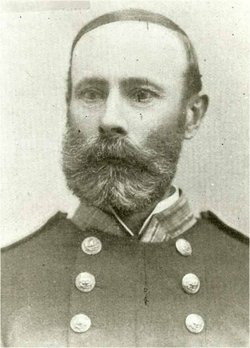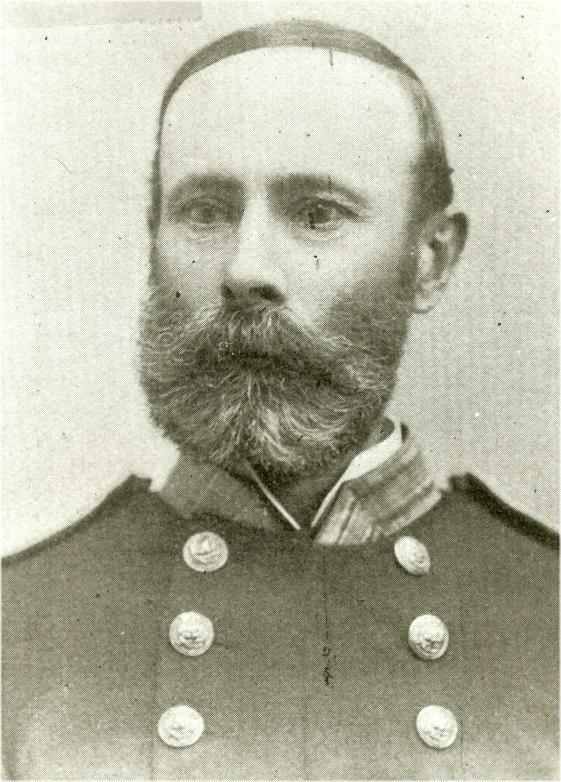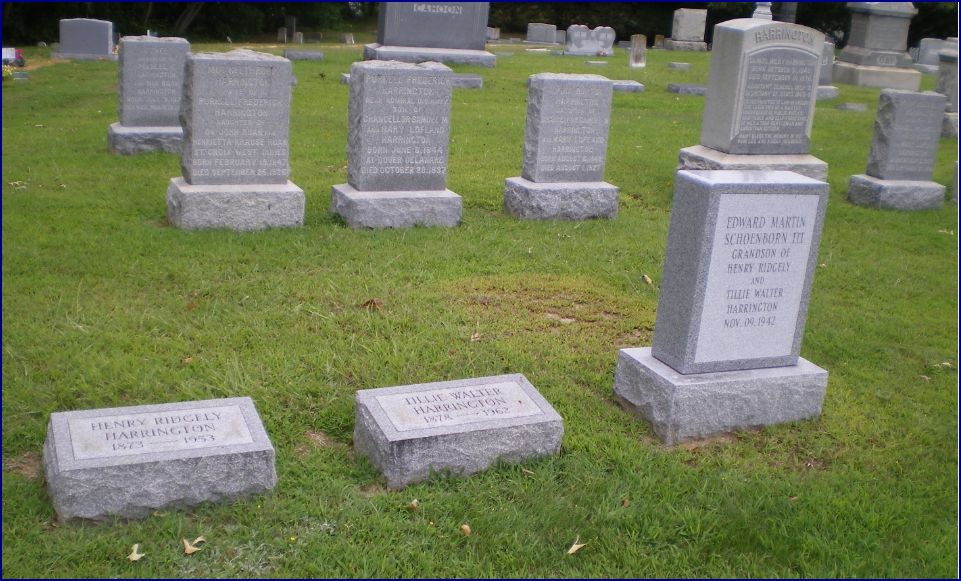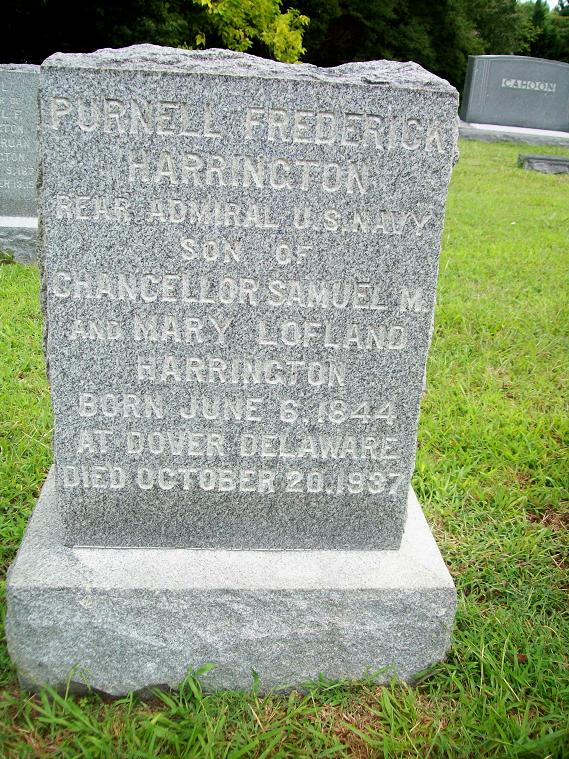Acting Midshipman, 20 September, 1861. Acting Ensign, 1 October, 1863. Master, 10 May, 1866. Lieutenant, 21 February, 1867. Lieutenant Commander, 12 March, 1868. Commander, 28 May, 1881. Captain, 1 March, 1895.
Rear Admiral Purnell Frederick Harrington Commander-in-Chief 1925 - 1927 by Dr. Robert Girard Carroon, Past Commander-in-Chief Military Order of the Loyal Legion of the United States:
Purnell Frederick Harrington was a career naval officer who served as Commander-in-Chief from 1925 to 1927. A graduate of the U.S. Naval Academy, he was both a scholar and a blue water sailor of uncommon ability. Purnell was born in Dover, Delaware on June 6, 1844, the son of Samuel M. Harrington and Mary Lofland. Upon completion of high school he received an appointment to the U.S. Naval Academy and was mustered in as Acting Midshipman on September 20, 1861. On July 16, 1862 he was promoted to Midshipman and, upon graduation was appointed Acting Ensign.
Acting Ensign Harrington's first assignment was service on the U.S.S. Ticonderoga on duty with the North Atlantic Blockading Squadron from October 1863 through January 1864. He then was transferred to the U.S.S. Niagara on special service from January to June 1864 when he was transferred to the U.S.S. Monongahela with the Western Gulf Blockading Squadron. It was while serving on the Monongahela that Ensign Harrington participated in the Battle of Mobile Bay in the naval force under the command of Rear Admiral David Glasgow Farragut.
After shore leave at the end of the War of the Rebellion Acting Ensign Harrington returned to service on the Monongahela and was promoted Ensign on December 21, 1865. After his appointment as Master on May 10, 1866 Purnell Harrington was appointed Lieutenant on February 21, 1867 and assigned to the U.S. Naval Academy. After a two year tour of duty, during which he was promoted to Lieutenant Commander on March 12, 1868, he was assigned to temporary torpedo duty with the U.S.S. California on August, 1870, followed by appointment as executive officer on the U.S.S. Pensacola, flagship of the Pacific fleet from December 1870 through August 1873. He returned to the U.S. Naval Academy in September 1873 serving on the faculty until September 1876 when he became the executive officer of the U.S.S. Hartford with the South Atlantic Squadron. He returned to the faculty of the U.S. Naval Academy in January 1880 and was promoted to the rank of Commander on May 28, 1881. His next sea assignment was as captain of the U.S.S. Juanita on the Asiatic Station from March 1883 to January 1886 when he became Commandant of Cadets at the U.S. Naval Academy. While commanding the Juanita he was involved in U.S. affairs on Madagascar and the Comoro Islands, particularly the relationship between the Sultan of Johanna and Dr. B.F. Wilson, an American citizen.
Purnell Harrington's next assignment was as inspector of the 4th lighthouse district in Philadelphia where he served until 1893 when he assumed command of the U.S.S. Yorktown. Following his service on the Yorktown he went on special duty at the Navy Department in Washington D.C. and then assumed the presidency of the steel board of the U.S. Navy. Purnell Harrington was promoted to Captain, United States Navy, on March 1, 1895. After commanding the U.S.S. Terror with the North Atlantic Squadron from April 1896 to July 1897, Captain Harrington found himself in command of the U.S.S. Puritan at the outbreak of the Spanish American War. From November 1898 to October 1901 Captain Harrington was commandant of the Navy Yard at Portsmouth, New Hampshire. On March 21 1903 Captain Harrington was promoted to Rear Admiral and became commandant of the U.S. Navy Yard at Norfolk, Virginia. On 6 June 1906, after an illustrious career of service in the United States Navy and to the Republic Rear Admiral Harrington was placed on the retired list. His final military duty was in connection with the Jamestown Exposition from July 1906 to January 1908.
A scholar in the area of nautical engineering he wrote a number of articles bearing such titles as "The Coefficient of Safety in Navigation" and "Notes of Navigation and the Determination of Meridian Distances for the Use of Naval Cadets at the U.S. Naval Academy." He is listed among the "founding fathers" of the U.S. Naval Institute.
Rear Admiral Harrington was elected a Companion of the First Class of the Military Order of the Loyal Legion on December 7, 1910 by the Commandery of the State of New York and assigned Insignia #16399. On May 1, 1912 he was elected Sr. Vice Commander of the New York Commandery and on February 15, 1913 he became Commander. In 1923 he was elected Sr. Vice Commander-in-Chief. Rear Admiral Harrington succeeded Lt. General Nelson Appleton Miles as Commander-in-Chief upon the latter's death.
On August 5, 1868 Purnell Frederick Harrington was married to Mia N. Ruan of St. Croix, Danish West Indies, and they had four children including Colonel Samuel Milby Harrington USMC who was a hereditary companion of MOLLUS with Insignia No. 16527. Rear Admiral Harrington died at his home in Yonkers, New York, on October 20, 1937.
Acting Midshipman, 20 September, 1861. Acting Ensign, 1 October, 1863. Master, 10 May, 1866. Lieutenant, 21 February, 1867. Lieutenant Commander, 12 March, 1868. Commander, 28 May, 1881. Captain, 1 March, 1895.
Rear Admiral Purnell Frederick Harrington Commander-in-Chief 1925 - 1927 by Dr. Robert Girard Carroon, Past Commander-in-Chief Military Order of the Loyal Legion of the United States:
Purnell Frederick Harrington was a career naval officer who served as Commander-in-Chief from 1925 to 1927. A graduate of the U.S. Naval Academy, he was both a scholar and a blue water sailor of uncommon ability. Purnell was born in Dover, Delaware on June 6, 1844, the son of Samuel M. Harrington and Mary Lofland. Upon completion of high school he received an appointment to the U.S. Naval Academy and was mustered in as Acting Midshipman on September 20, 1861. On July 16, 1862 he was promoted to Midshipman and, upon graduation was appointed Acting Ensign.
Acting Ensign Harrington's first assignment was service on the U.S.S. Ticonderoga on duty with the North Atlantic Blockading Squadron from October 1863 through January 1864. He then was transferred to the U.S.S. Niagara on special service from January to June 1864 when he was transferred to the U.S.S. Monongahela with the Western Gulf Blockading Squadron. It was while serving on the Monongahela that Ensign Harrington participated in the Battle of Mobile Bay in the naval force under the command of Rear Admiral David Glasgow Farragut.
After shore leave at the end of the War of the Rebellion Acting Ensign Harrington returned to service on the Monongahela and was promoted Ensign on December 21, 1865. After his appointment as Master on May 10, 1866 Purnell Harrington was appointed Lieutenant on February 21, 1867 and assigned to the U.S. Naval Academy. After a two year tour of duty, during which he was promoted to Lieutenant Commander on March 12, 1868, he was assigned to temporary torpedo duty with the U.S.S. California on August, 1870, followed by appointment as executive officer on the U.S.S. Pensacola, flagship of the Pacific fleet from December 1870 through August 1873. He returned to the U.S. Naval Academy in September 1873 serving on the faculty until September 1876 when he became the executive officer of the U.S.S. Hartford with the South Atlantic Squadron. He returned to the faculty of the U.S. Naval Academy in January 1880 and was promoted to the rank of Commander on May 28, 1881. His next sea assignment was as captain of the U.S.S. Juanita on the Asiatic Station from March 1883 to January 1886 when he became Commandant of Cadets at the U.S. Naval Academy. While commanding the Juanita he was involved in U.S. affairs on Madagascar and the Comoro Islands, particularly the relationship between the Sultan of Johanna and Dr. B.F. Wilson, an American citizen.
Purnell Harrington's next assignment was as inspector of the 4th lighthouse district in Philadelphia where he served until 1893 when he assumed command of the U.S.S. Yorktown. Following his service on the Yorktown he went on special duty at the Navy Department in Washington D.C. and then assumed the presidency of the steel board of the U.S. Navy. Purnell Harrington was promoted to Captain, United States Navy, on March 1, 1895. After commanding the U.S.S. Terror with the North Atlantic Squadron from April 1896 to July 1897, Captain Harrington found himself in command of the U.S.S. Puritan at the outbreak of the Spanish American War. From November 1898 to October 1901 Captain Harrington was commandant of the Navy Yard at Portsmouth, New Hampshire. On March 21 1903 Captain Harrington was promoted to Rear Admiral and became commandant of the U.S. Navy Yard at Norfolk, Virginia. On 6 June 1906, after an illustrious career of service in the United States Navy and to the Republic Rear Admiral Harrington was placed on the retired list. His final military duty was in connection with the Jamestown Exposition from July 1906 to January 1908.
A scholar in the area of nautical engineering he wrote a number of articles bearing such titles as "The Coefficient of Safety in Navigation" and "Notes of Navigation and the Determination of Meridian Distances for the Use of Naval Cadets at the U.S. Naval Academy." He is listed among the "founding fathers" of the U.S. Naval Institute.
Rear Admiral Harrington was elected a Companion of the First Class of the Military Order of the Loyal Legion on December 7, 1910 by the Commandery of the State of New York and assigned Insignia #16399. On May 1, 1912 he was elected Sr. Vice Commander of the New York Commandery and on February 15, 1913 he became Commander. In 1923 he was elected Sr. Vice Commander-in-Chief. Rear Admiral Harrington succeeded Lt. General Nelson Appleton Miles as Commander-in-Chief upon the latter's death.
On August 5, 1868 Purnell Frederick Harrington was married to Mia N. Ruan of St. Croix, Danish West Indies, and they had four children including Colonel Samuel Milby Harrington USMC who was a hereditary companion of MOLLUS with Insignia No. 16527. Rear Admiral Harrington died at his home in Yonkers, New York, on October 20, 1937.
Inscription
husband of Mia Nelthropp Harrington - son of Mary Lofland & Chancellor Samuel M. Harrington - Rear Admiral, U. S. Navy
Family Members
Sponsored by Ancestry
Advertisement
Records on Ancestry
Advertisement





















